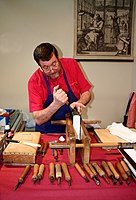
Photo from wikipedia
In the wind energy sector, automotive and aviation industries, non-crimp fabrics have been established for many years. Non-crimp fabrics are also increasingly being sought in the construction sector. Due the… Click to show full abstract
In the wind energy sector, automotive and aviation industries, non-crimp fabrics have been established for many years. Non-crimp fabrics are also increasingly being sought in the construction sector. Due the connection to the concrete, the non-crimp fabrics with a grid-like open structure are used as textile reinforcements. This paper presents the development of alternative stitch-free bonding technologies for non-crimp fabrics based on multiple carbon fiber heavy tows for textile-reinforced concrete components. For this purpose, an initial analysis is carried out to find out the effect of impregnation on the number of roving layers. Further examinations to determine the process-related limits and mechanical process parameters for using this kind of rovings in textile machines are performed on the influence of multiple roving tension on changes width. Finally, the strength of the bonding points of the non-crimp fabrics produced in a laboratory scale is thoroughly investigated by varying the grid geometry, number of roving layers and bonding technology. The investigations show a good potential of the developed bonding technologies for the production of alternative bonded stitch-free non-crimp fabrics. Compared to grid-like open structures, which are connected by stitching threads, the strength of the bonding points can be increased up to 30%, by the developed stitch-free bonding technologies.
Journal Title: Journal of Industrial Textiles
Year Published: 2018
Link to full text (if available)
Share on Social Media: Sign Up to like & get
recommendations!